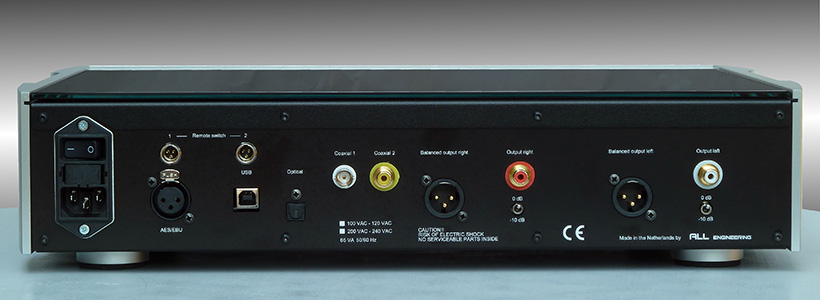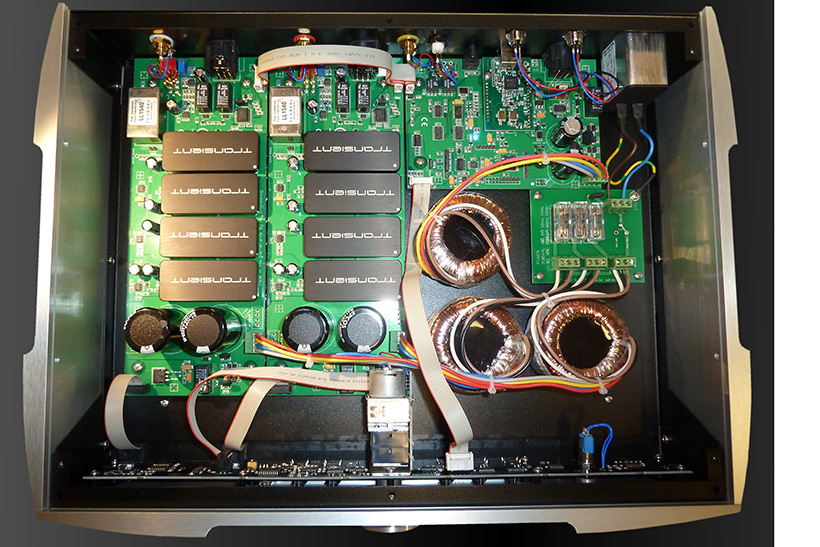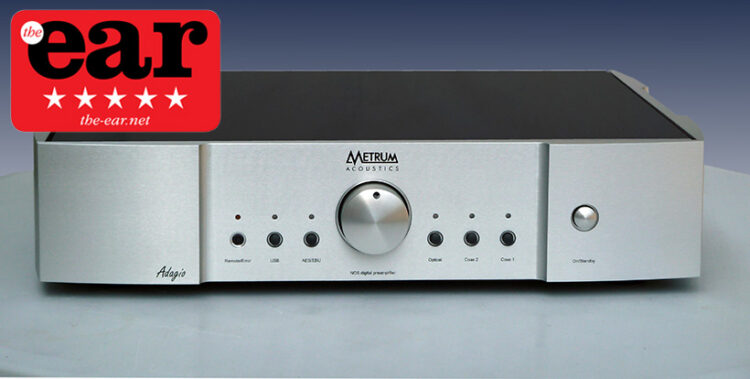From the first digital to analogue converter ever made by Metrum Acoustics they have taken a different route to most manufacturers. The majority use conversion chips by Burr Brown, Philips, TI or Wolfson to name a few, Metrum selected an industrial DAC chip and claimed its high speed architecture improved the conversion. A lot of reviewers and customers agreed. Loyal to the non-oversampling, non-filtering approach Metrum continued to bring converters to the market, every one better than the last up to the Pavane last year. When the market asked for a DAC-preamplifier Metrum’s Cees Ruijtenberg looked at the Pavane and started a project to create the Adagio. Where not only is the volume control new, but some important changes have been made to the architecture as well.
New to the Adagio are Transient DAC Two modules, a further development of the Transient and FPGA architecture used in the Pavane DAC. Inside each module are two 16-bit R2R ladder converters and one FPGA. When a 16 to 24 bit signal enters the module it is split into two sections by the FPGA. The upper bits are passed directly to one of the R2R converters, while the lower bits are raised to the highest level before they reach the second R2R converter. This increase in level is done so as to use the highest voltage on the ladder resistors, moving away from the relativel noisy, low level signal part that exists in all types of converter. Before the output stage the signal level of the second converter needs to be adjusted to the correct level and combined with the original upper part to create the correct output signal. Metrum manipulates the least significant bits (LSB) because lower level irregularities occur, non-linearity arises and digital noise becomes part of the analogue signal with lower level signals. These modules reduce noise by -145dB or more. This might sound simple but it took years to write the algorithms for the FPGA and to develop the Transient DAC Two R2R converters. The Adagio resembles the Pavane DAC inside and outside but there are major differences. In the Pavane a single FPGA is used with eight Transient DAC One modules, each with one 16-bit R2R converter inside. The Adagio doubles the number of converters because each of the DAC Two modules has its own FPGA and two converters inside. Doubling the number of converters has always proved to be beneficial, even in the days of the TDA1541 or PCM63 multibit chips. The shorter signal path between FPGA and converters has proven to be an advantage too.

Metrum Acoustics could have taken the easy route and used bit reduction to create a volume control, this is how it’s done on most affordable DACs. The next option is to use a volume control in the analogue stage followed by a buffer stage before the outputs. But potentiometers, no matter how good, colour the sound and minor details in the music get lost. Reaching for the moon and shooting a star Metrum came up with the idea of changing the reference voltage for the DAC modules to influence the output level. Therefor three new and more powerful 75VA transformers are used in the Adagio DAC/preamp and the rotary control on the front does not alter the music signal, it lowers or increases the reference voltage on the R2R ladders. It’s very clever but has one small disadvantage, the only way to make the Adagio completely silent is with the mute button on the remote control, otherwise a low signal level is always present at the output when there is an incoming signal. The volume control turns the Adagio into a digital preamplifier able to feed any power amplifier either balanced on XLR or transformer coupled unbalanced on RCA.
The Adagio is a full size 42cm wide box with aluminium casing that can be silver or black, in both cases it is covered by black glass on the top. The curved front plate holds one large pushbutton for standby and five small ones for input, the volume control is in the middle. Optical, RCA, BNC, AES/EBU and USB are standard inputs and a blue LED above each button indicates the input in use. An orange LED lights up when there is no data at the input. The remote control makes it possible to choose an input and adjust the volume from listening position. The back has the inputs, the RCA and XLR outputs, toggle switches for reducing the output level, two mini XLR connectors to switch on/off the forthcoming Metrum Forte power amplifiers, next to the mains switch and mains inlet. The working principle is non-oversampling, forward corrected, with four DAC Two modules per channel in differential mode for a truly balanced signal path.
I have used digital to analogue converters with a volume control inside before and connected them either directly or through a separate preamplifier to all kind of power amplifiers. At first it mostly seemed an advantage to skip the preamp, but after a week or so I missed the powerful drive only a good preamp can provide. Or I missed having analogue inputs and flexibility. And there are no analogue inputs on the Adagio but I have used it extensively in my two systems. The smaller one comprises a Bluesound Node 2 as digital source, Pass Labs XP-10 preamp, XA30.5 power amp and a pair of Harbeth P3ESR loudspeakers. The main system is built around a NAD M50/M52 streamer, Audia Flight Strumento No.1 preamp, Pass Labs X250.5 power amp and a pair of PMC fact.12 loudspeakers. In both cases I used the Adagio as DAC only to replace a NAD M51 and Metrum Acoustics Pavane, or as a digital preamp by simply swapping interconnect cables to the power amps.

After warming up the Adagio for a couple of days I compared the NAD M51 to the Adagio, only to find that both DACs are capable of reproducing music up to a high quality level. But it was the Adagio that proved that converting a digital signal into an analogue one is not as easy as it looks. The longer I listened the more music became real and less and less coloured with digital glare. This has everything to do with feeling and experiencing what the musicians wish to express and less with measuring results with instruments rather than ears. In other ways, like details or dynamics both DACs performed at the same level albeit the Adagio had the advantage over the M51. After a week or so it was hard to switch back to the M51, I had got used to the flow of music in a truly analogue way. The next step is of course to take away my Pass Labs XP-10 preamp and connect the Adagio directly to the XA30.5 power amp. This was never successful with the M51 which needs the warmth of the Pass for beautiful but clear voicing. With the Adagio directly connected it became clear that the XP-10 not only colours the sound with warmth, it is also an obstacle to (tiny) details, dynamics and realism. Being overwhelmed with the results it became harder and harder to pull myself away from the music and return to every day family business. The way that music escapes from the loudspeakers is hard to describe other than to say it is coming from a high end record player with a fine cartridge and excellent phono stage. The ease and the flow is remarkable for a system with only small loudspeakers and a small class A amplifier. There is nothing in the signal path to restrain the music. The exploding tambourine on ‘Slow boat to China’ from Dee Dee Bridgewater’s Live at Yoshi’s is a fine example of the speed and unlimited dynamics of the Adagio. The piano notes on ‘Spiegel im Spiegel’ by Arvo Pärt have never been more subtle in this room. Imaging starts a little before the loudspeakers and goes far behind them, as wide as the original recording permits. The loudspeakers themselves disappear totally and only return when I opened my eyes to check they are still in the room. And although acoustic instruments really shine and sound right on every note, even electronic noise by Infected Mushroom had me turning up the volume to deafening levels. Pushing the meter on the XA30.5 towards the right side of the scale. It was my wife that stopped me, unable to hear the TV elsewhere in our apartment and upset by the thundering sound! Later that week I moved the Adagio to my main system and returned to the original M51/XP-10 combi. They do sound very good together, especially when you consider this is my ‘small system’, but the Adagio is dearly missed.
In my main system the Adagio and Pavane are carefully levelled for equal output. By swapping both digital and analogue interconnects it soon became clear that the DAC Two modules have an advantage over the FPGA/Dac One combination. It is again the ease and flow that improves the most but realism is a few steps higher on the ladder, dynamics improve and more and more tiny details come forward. Like the singing of cymbals, the way they sound even more metallic and take longer to fade into the background. Or the way voices are projected into the room, a little clearer and more lifelike. The signature of Metrum Acoustics is available from both DACs, although the Adagio with the new Transient modules, a more powerful supply and higher working voltage is clearly the better one. I am not sure whether I should upgrade from the Pavane to the Adagio or not at this stage, it may also depend on how the Adagio works directly into the power amp by removing the preamp from the system. But I can say that if I was a first time buyer I would seriously consider saving the expense of a preamplifier and getting an Adagio. Once heard it might turn your idea of digital to analogue conversion upside down.

Here we are, the shortest signal path from digital source, into the DAC/preamp, power amp and loudspeakers. The NAD M50 is connected to the Adagio DAC with XLR cable, and directly connected to my Pass X250.5. I have been listening for some days before I put on Nik Bärtsch’s Mobile Continuum with the deeper than deep bass tones thundering over the floor. The high resolution file turns percussion into an absolute highlight with the Adagio in place. It’s not only clear and defined but it also sounds perfectly right and lifelike. Rhythm is strong, not only because of the tight bass and the drums, the Adagio is fast and that can be heard in the piano notes. Stereo image is excellent, honestly I don’t think I could expect more from a converter. Maybe the above looks like the Adagio is a more technical than musical converter, but this is not the case. It is only music with emotion and impact that I hear. To prove this I play some Lori Liebermann tracks from Ready For The Storm. Having seen Lori live a couple of times and from talking to her I know what I should get from the music. Her voice is warm and tender, her guitar and band nicely spread in front of me. The stage is not as wide as I can remember with my preamp in the system, but it comes away from the loudspeaker very nicely and produces a deep stage with natural height. In ‘Last Thing On My Mind’ it gets even more intimate and Lori carries me away with her thoughts.
On Philip Glass’ Metamorphosis; The Hours played by Lavinia Meijer the harp flows into the room with such ease in this hypnotising music that I close my eyes and enjoy a couple of tracks before I can tear myself away for something else. It must be the naturalness of the Adagio that intrigues me most of all. You simply cannot listen to the technical merits of the converter, it takes you into an experience, a musical voyage where you meet the musicians and become one with most of them. Dee Dee Bridgewater is one of the singers I meet, she is Live at Yoshi’s again, performing her ‘Slowboat to China’ and even though I know a tambourine will be hit hard I jump out of my chair when it happens. The Adagio is extremely fast and my Pass amp is dynamic enough to keep up. I need to mention the bass again, detailed, tight and with a lot of impact. This song from an album made in 2000 is so beautiful, it should be in everyone’s collection if only to judge audio equipment if you can’t stand jazz. I unplug the Adagio from the power amplifier and route the signal back through my Audia Flight Strumento No.1 preamplifier. The first thing I notice is that the tambourine strikes are not that fast and dynamic anymore. It’s a bit like the ‘late at night’ reduction of dynamics that some audio equipment has on offer. On the other hand the enormous driving capability of the preamp makes my loudspeaker disappear from the room in an ever wider soundstage. The audience’s response in the beginning and at the end are a bit more clear and present in a deeper stage. You win and you lose by inserting the preamp in this system. Where my Pass XP-10 could better be left out the Audia Flight brings extra benefits. Remembering the price of this piece, plus an interconnect and power cord I wonder how many listeners would spend the money and how many would use the Adagio as a preamp. Given that in my two setups the differences are so evident for and against a standalone preamp I think everyone should try this at home.

That takes me to the final words from my side about the Metrum Acoustics Adagio. It is for sure the best converter Metrum has made to date. The use of eight Transient DAC Two modules each with built-in FPGA and two R2R ladder converters to split the digital signal and join the analogue part again is an advantage over the solution in the Pavane (one FPGA in the unit and one R2R converter in each DAC One module). This probably has something to do with a shorter signal path and the doubling of the total number of converters. Then an even more powerful supply is used. The clever implementation of the volume control by lowering or raising the reference voltage in the converters is something I have never seen before and works flawlessly. No matter what the volume setting the sound won’t change in quality, resolution or any other way you can think of. The main use of the Adagio will be as a DAC and preamp combined in one, however if you own a very expensive preamp with a lot of headroom and even more drive you might want to keep that in place. The Adagio is a major step to the last word in conversion and allows digital sources to get as close to the original recording as possible. Me, I simply love this DAC and would put it in both my systems if funds would permit.


